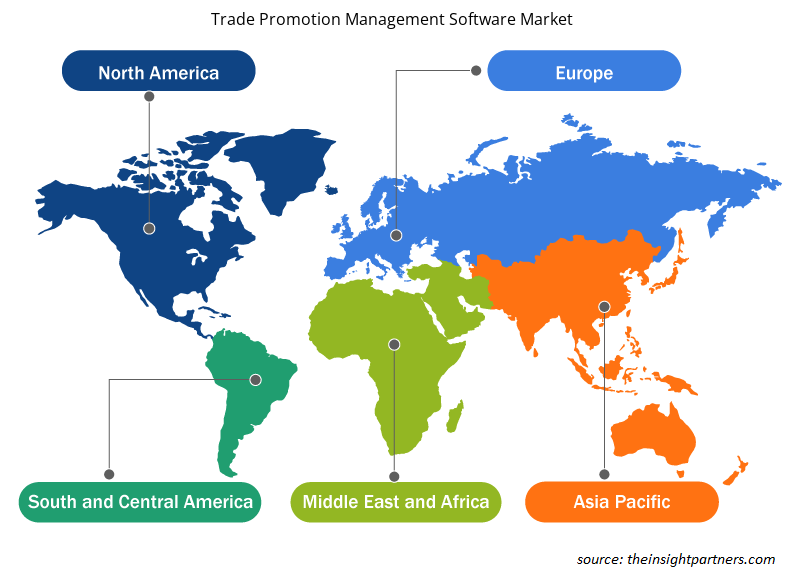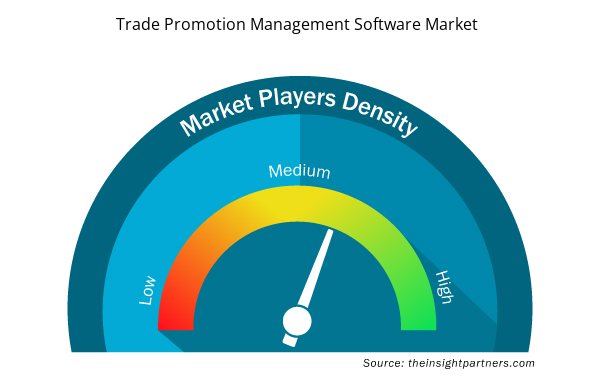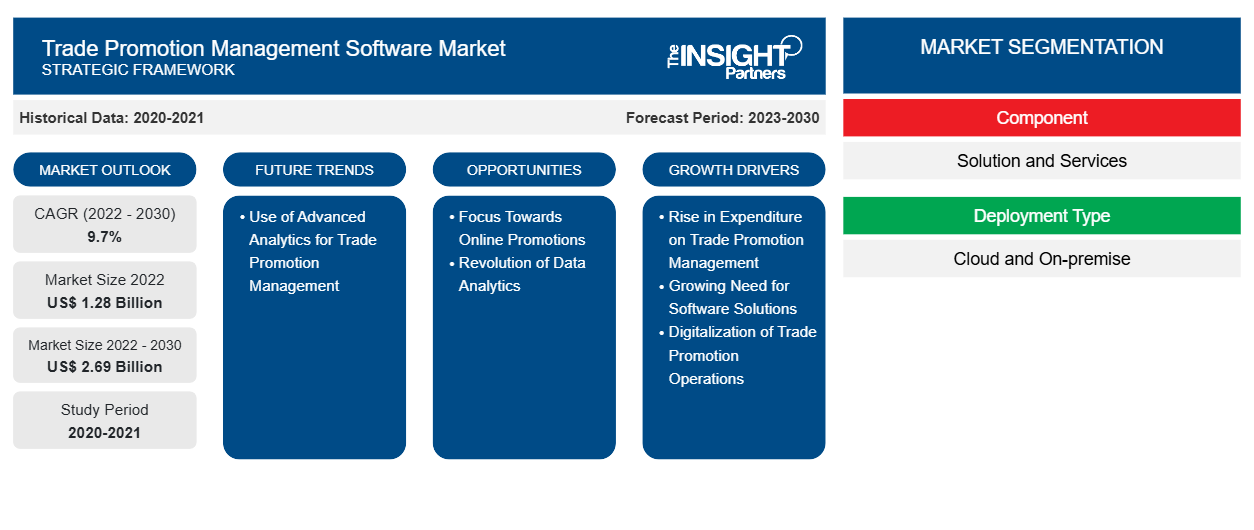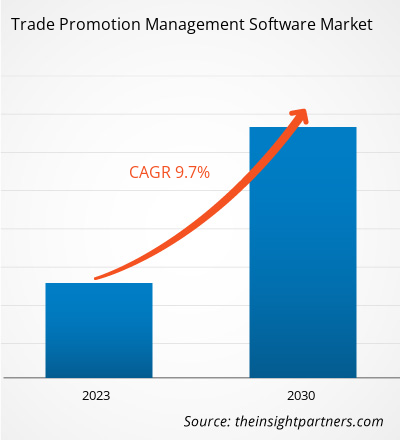[研究报告] 2022 年贸易促销管理软件市场规模价值 12.8 亿美元,预计到 2030 年将达到 26.9 亿美元。预计 2022 年至 2030 年贸易促销管理软件市场的复合年增长率为 9.7%。
分析师观点:
贸易促销管理软件市场是一个复杂且不断发展的生态系统,涵盖了广泛的利益相关者、技术和解决方案。这个生态系统的核心是消费品 (CG) 公司,它们使用贸易促销管理软件来管理与零售商和批发商的贸易促销。这些促销可以作为价格折扣、优惠券、展示和广告提供。作为贸易促销管理软件的主要用户,CG 公司依靠这些解决方案来规划、执行和跟踪其贸易促销的有效性。零售商和批发商是贸易促销管理过程中的重要合作伙伴,因为他们在销售点实施和执行贸易促销方面发挥着至关重要的作用。各种各样的公司都提供贸易促销管理软件解决方案,以满足各种规模和行业的 CG 公司的特定需求。CG 公司越来越多地寻求能够帮助他们推动销售、提高利润率并在不断扩张的消费品行业中获得竞争优势的贸易促销管理解决方案。
贸易促销管理软件市场概览:
贸易促销管理软件是组织用来制定、规划、执行和管理与贸易促销活动相关的运营的工具。利用贸易促销软件的目的是增加收入并最大化利润。制造商、零售商和供应商使用该软件来利用各种策略,例如定价策略、产品展示以及优惠和折扣。
贸易促销管理软件市场的增长归因于消费品行业的增长,这是由于全球人均 GDP 的增长和现代生活方式的适应。此外,通过分析生产和销售规划的需求和供应力量,在各个垂直行业中做出数据驱动的决策的需求日益增加,这是促进贸易促销管理软件市场增长的其他因素之一。然而,某些发展中国家和欠发达国家缺乏贸易促销管理软件的采用,阻碍了市场的增长。此外,COVID-19 疫情对市场的增长产生了轻微影响。
定制此报告以满足您的需求
您可以免费定制任何报告,包括本报告的部分内容、国家级分析、Excel 数据包,以及为初创企业和大学提供优惠和折扣
- 获取此报告的关键市场趋势。这个免费样品将包括数据分析,从市场趋势到估计和预测。
贸易促销管理软件市场驱动因素:
贸易促销运营数字化推动贸易促销管理软件市场增长
贸易促销的数字化转型为 消费品包装商品 (CPG) 公司快速适应、提高收入和保持最佳利润率奠定了基础。成功的数字贸易促销管理策略需要深思熟虑、多方面且数据驱动的方法。虽然企业必须在组织内部有效地管理贸易促销,但与零售商的合作对于长期成功至关重要。快速消费品公司和零售商之间的互利协议可以促进两家公司的信任和发展。参与贸易促销运营的多个部门(如收入管理、财务和营销)之间的协调也至关重要。为了保证流程高效成功,必须有所有权和责任制,以及激励措施。必须跟踪每个贸易促销的生命周期。还需要访问实体店以检查计划的促销活动是否得到执行,并将信息与 ePoS(电子销售点)数据进行交叉引用。分析应用程序需要利用内部和外部数据。自动化和先进的统计分析工具可以对贸易促销计划的某些部分提供详细的见解,帮助企业微调其方法。通过这些数字策略,快速消费品组织可以继续与每个客户建立联系。因此,贸易促销业务数字化的兴起推动了贸易促销管理软件市场的增长。
贸易促销管理软件市场报告细分和范围:
根据组件,贸易促销管理软件市场分为解决方案和服务。根据部署类型,贸易促销管理软件市场分为云和本地部署。在应用方面,贸易促销管理软件市场分为大型企业和中小型企业。根据行业,贸易促销管理软件市场分为零售和消费品、IT、制药、制造业和其他。在地理方面,全球贸易促销管理软件市场分为五大地区——北美、欧洲、亚太地区 (APAC)、中东和非洲 (MEA) 和南美 (SAM)。
贸易促销管理软件市场细分分析:
根据应用,贸易促销管理软件市场分为大型企业和中小企业。大型企业部门在 2022 年占据了更大的贸易促销管理软件份额,中小企业部门预计在预测期内将录得更高的复合年增长率。员工人数超过 500 人的组织被归类为大型企业。大型企业在不同的地理区域都有客户;它们占据了相当大的市场份额、技术能力和有效的商业战略。这些大型企业通常会投资于最新的创新技术来有效地运营他们的业务。随着贸易促销管理软件工具在各个行业中功能不断增强,这些工具的采用在过去几年中获得了发展动力。大型企业正在利用各种分析工具(如贸易促销管理软件)来有效地简化业务运营。
贸易促销管理软件市场区域分析:
2022 年,北美贸易促销管理软件市场规模价值 4.8182 亿美元,预计到 2030 年将达到 9.3807 亿美元;预计 2022 年至 2030 年的复合年增长率为 8.7%。北美贸易促销管理软件市场分为美国、加拿大和墨西哥。2022 年,美国占据北美贸易促销管理软件市场的最大份额。
美国、加拿大和墨西哥是北美的主要经济体。该地区的各零售商正在对先进的技术解决方案进行大量投资,以获得比前几年更高的投资回报率 (ROI)。由于该地区的消费者(尤其是美国消费者)在食品杂货上花费巨大,许多零售初创公司正在进入北美市场。此外,零售商和科技公司正在合作,在促销活动上投入大量资金,以吸引新买家并留住现有买家。
在北美,消费品公司是贸易促销管理解决方案的主要终端用户。该地区由可口可乐、雀巢、百事可乐、宝洁、菲利普莫里斯、欧莱雅和卡夫食品等知名消费品公司组成。由于这些领先的消费品公司的存在,促销活动的支出正在增加。为了在消费品领域保持竞争力,这些公司不断投资广告和其他促销活动,以提升品牌形象并刺激销售。
北美见证了提供贸易促销管理解决方案的公司的足迹。例如,Adesso 通过其贸易促销管理解决方案帮助其客户提高贸易促销管理和效率。该解决方案对北美的小型、中型和新兴消费品包装制造商非常有效。因此,贸易促销管理解决方案提供商的足迹和北美消费品行业的增长预计将创造对贸易促销管理软件的需求,以有效管理贸易促销活动。
贸易促销管理软件市场关键参与者分析:
Aera Technology;TELUS;o9 Solutions, Inc.;Oracle;SAP SE;UpClear;Anaplan, Inc.;Aforza Inc.;Wipro 和 Psignite Inc 是贸易促销管理软件市场的主要公司。
贸易促销管理软件市场区域洞察
Insight Partners 的分析师已详尽解释了预测期内影响贸易促销管理软件市场的区域趋势和因素。本节还讨论了北美、欧洲、亚太地区、中东和非洲以及南美和中美洲的贸易促销管理软件市场细分和地理位置。

- 获取贸易促销管理软件市场的区域特定数据
贸易促销管理软件市场报告范围
| 报告属性 | 细节 |
|---|---|
| 2022 年市场规模 | 12.8亿美元 |
| 2030 年的市场规模 | 26.9 亿美元 |
| 全球复合年增长率(2022 - 2030 年) | 9.7% |
| 史料 | 2020-2021 |
| 预测期 | 2023-2030 |
| 涵盖的领域 | 按组件
|
| 覆盖地区和国家 | 北美
|
| 市场领导者和主要公司简介 |
|
市场参与者密度:了解其对商业动态的影响
贸易促销管理软件市场正在快速增长,这得益于最终用户需求的不断增长,而这些需求又源于消费者偏好的不断变化、技术进步以及对产品优势的认识不断提高等因素。随着需求的增加,企业正在扩大其产品范围,进行创新以满足消费者的需求,并利用新兴趋势,从而进一步推动市场增长。
市场参与者密度是指在特定市场或行业内运营的企业或公司的分布情况。它表明在给定市场空间中,相对于其规模或总市场价值,有多少竞争对手(市场参与者)存在。
在贸易促销管理软件市场运营的主要公司有:
- 威普罗有限公司
- PSignite集团公司
- 艾瑞科技
- 研科
- o9 解决方案有限公司
免责声明:上面列出的公司没有按照任何特定顺序排列。

- 获取贸易促销管理软件市场顶级关键参与者概览
贸易促销管理软件市场最新发展:
贸易促销管理软件市场中的公司大量采用并购等无机和有机策略。以下列出了一些近期贸易促销管理软件市场的关键发展情况:
- 2023 年 1 月,Oracle 宣布了一系列新的云功能。Price Hub 扩展了 Oracle 零售商品云服务,以实现定价流程自动化,因此零售商可以轻松更新一系列产品的购买价格,从而最大限度地提高销售额和利润。Oracle 零售客户参与云服务中的新促销功能可帮助零售商通过提供更个性化和更具吸引力的优惠来增加收入和盈利能力。这些云服务在 Oracle 云基础设施 (OCI) 上运行。
- 2022 年 2 月,SAP 发布了 SAP 贸易促销管理功能包 6,进一步扩大了 SAP 在消费品销售流程中的领导地位。
- 2020 年 9 月,TELUS 与 AFS Technologies 和 Exceedra 合作,解决各种业务问题。该公司始终致力于支持客户的潜力,从确保实时获取信息到优化上市的最后步骤,再到确保货架空间和即时与客户联系。
- 历史分析(2 年)、基准年、预测(7 年)及复合年增长率
- PEST 和 SWOT 分析
- 市场规模价值/数量 - 全球、区域、国家
- 行业和竞争格局
- Excel 数据集



Report Coverage
Revenue forecast, Company Analysis, Industry landscape, Growth factors, and Trends

Segment Covered
This text is related
to segments covered.

Regional Scope
North America, Europe, Asia Pacific, Middle East & Africa, South & Central America

Country Scope
This text is related
to country scope.
常见问题
The Global trade promotion management software market was estimated to be US$ 1.28 billion in 2022 and is expected to grow at a CAGR of 9.7% % during the forecast period 2023 - 2030.
Rise in Expenditure on Trade Promotion Management is one of the drivers for the market.
Use of Advanced Analytics for Trade Promotion Management is impacting positive impact, which is anticipated to play a significant role in the Global trade promotion management software market in the coming years.
The incremental growth expected to be recorded for the Global trade promotion management software market during the forecast period is US$ 1.40 billion.
The key players holding majority shares in the Global trade promotion management software market are Oracle, Anaplan, Inc., Aera Technology, SAP SE, TELUS.
The Global trade promotion management software market is expected to reach US$ 2.69 billion by 2030.
Trends and growth analysis reports related to Technology, Media and Telecommunications : READ MORE..
The List of Companies - Trade Promotion Management Software Market
- Wipro Ltd
- PSignite Group Inc
- Aera Technology
- TELUS
- o9 Solutions, Inc.
- Oracle Corp
- SAP SE
- UpClear
- Anaplan Inc
- Aforza Inc
The Insight Partners performs research in 4 major stages: Data Collection & Secondary Research, Primary Research, Data Analysis and Data Triangulation & Final Review.
- Data Collection and Secondary Research:
As a market research and consulting firm operating from a decade, we have published and advised several client across the globe. First step for any study will start with an assessment of currently available data and insights from existing reports. Further, historical and current market information is collected from Investor Presentations, Annual Reports, SEC Filings, etc., and other information related to company’s performance and market positioning are gathered from Paid Databases (Factiva, Hoovers, and Reuters) and various other publications available in public domain.
Several associations trade associates, technical forums, institutes, societies and organization are accessed to gain technical as well as market related insights through their publications such as research papers, blogs and press releases related to the studies are referred to get cues about the market. Further, white papers, journals, magazines, and other news articles published in last 3 years are scrutinized and analyzed to understand the current market trends.
- Primary Research:
The primarily interview analysis comprise of data obtained from industry participants interview and answers to survey questions gathered by in-house primary team.
For primary research, interviews are conducted with industry experts/CEOs/Marketing Managers/VPs/Subject Matter Experts from both demand and supply side to get a 360-degree view of the market. The primary team conducts several interviews based on the complexity of the markets to understand the various market trends and dynamics which makes research more credible and precise.
A typical research interview fulfils the following functions:
- Provides first-hand information on the market size, market trends, growth trends, competitive landscape, and outlook
- Validates and strengthens in-house secondary research findings
- Develops the analysis team’s expertise and market understanding
Primary research involves email interactions and telephone interviews for each market, category, segment, and sub-segment across geographies. The participants who typically take part in such a process include, but are not limited to:
- Industry participants: VPs, business development managers, market intelligence managers and national sales managers
- Outside experts: Valuation experts, research analysts and key opinion leaders specializing in the electronics and semiconductor industry.
Below is the breakup of our primary respondents by company, designation, and region:

Once we receive the confirmation from primary research sources or primary respondents, we finalize the base year market estimation and forecast the data as per the macroeconomic and microeconomic factors assessed during data collection.
- Data Analysis:
Once data is validated through both secondary as well as primary respondents, we finalize the market estimations by hypothesis formulation and factor analysis at regional and country level.
- Macro-Economic Factor Analysis:
We analyse macroeconomic indicators such the gross domestic product (GDP), increase in the demand for goods and services across industries, technological advancement, regional economic growth, governmental policies, the influence of COVID-19, PEST analysis, and other aspects. This analysis aids in setting benchmarks for various nations/regions and approximating market splits. Additionally, the general trend of the aforementioned components aid in determining the market's development possibilities.
- Country Level Data:
Various factors that are especially aligned to the country are taken into account to determine the market size for a certain area and country, including the presence of vendors, such as headquarters and offices, the country's GDP, demand patterns, and industry growth. To comprehend the market dynamics for the nation, a number of growth variables, inhibitors, application areas, and current market trends are researched. The aforementioned elements aid in determining the country's overall market's growth potential.
- Company Profile:
The “Table of Contents” is formulated by listing and analyzing more than 25 - 30 companies operating in the market ecosystem across geographies. However, we profile only 10 companies as a standard practice in our syndicate reports. These 10 companies comprise leading, emerging, and regional players. Nonetheless, our analysis is not restricted to the 10 listed companies, we also analyze other companies present in the market to develop a holistic view and understand the prevailing trends. The “Company Profiles” section in the report covers key facts, business description, products & services, financial information, SWOT analysis, and key developments. The financial information presented is extracted from the annual reports and official documents of the publicly listed companies. Upon collecting the information for the sections of respective companies, we verify them via various primary sources and then compile the data in respective company profiles. The company level information helps us in deriving the base number as well as in forecasting the market size.
- Developing Base Number:
Aggregation of sales statistics (2020-2022) and macro-economic factor, and other secondary and primary research insights are utilized to arrive at base number and related market shares for 2022. The data gaps are identified in this step and relevant market data is analyzed, collected from paid primary interviews or databases. On finalizing the base year market size, forecasts are developed on the basis of macro-economic, industry and market growth factors and company level analysis.
- Data Triangulation and Final Review:
The market findings and base year market size calculations are validated from supply as well as demand side. Demand side validations are based on macro-economic factor analysis and benchmarks for respective regions and countries. In case of supply side validations, revenues of major companies are estimated (in case not available) based on industry benchmark, approximate number of employees, product portfolio, and primary interviews revenues are gathered. Further revenue from target product/service segment is assessed to avoid overshooting of market statistics. In case of heavy deviations between supply and demand side values, all thes steps are repeated to achieve synchronization.
We follow an iterative model, wherein we share our research findings with Subject Matter Experts (SME’s) and Key Opinion Leaders (KOLs) until consensus view of the market is not formulated – this model negates any drastic deviation in the opinions of experts. Only validated and universally acceptable research findings are quoted in our reports.
We have important check points that we use to validate our research findings – which we call – data triangulation, where we validate the information, we generate from secondary sources with primary interviews and then we re-validate with our internal data bases and Subject matter experts. This comprehensive model enables us to deliver high quality, reliable data in shortest possible time.


 获取此报告的免费样本
获取此报告的免费样本